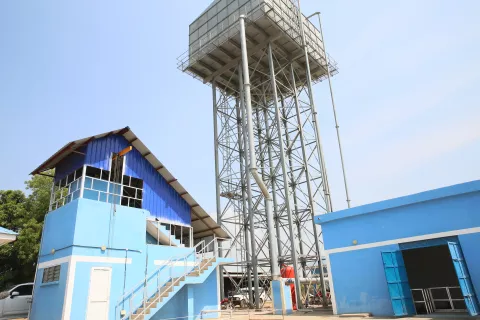“The river is taking our children”
UNICEF has an exciting solution literally in the pipeline

The wide river Nile is slowly moving between giant mango trees dotted with green unripen fruits which will become juicy and delicious in just a few months, creating a postcard pretty scene in one of Juba’s neighbourhood. The river is the artery in South Sudan’s capital, being the main water source for its population. While water is normally associated with giving life, this water is also taking lives. Children’s lives.
“I have only one request, can you please hurry?”, Joyce Ladu asks just as I am about to leave the Rejaf neighbourhood. She is excited about the news, but feels the community have no time to lose, as they have already lost so much.
I will let you in on the exciting news later.

“We use that water for everything. We wash our clothes in it, we wash ourselves and we drink it,” says Margaret Alek, a mother of ten. She has lived in the Rejaf community for 14 years, and the river has always been the main water source. “We either have to go and get it ourselves which is free, or we buy from the water trucks that comes to the community and pay 400 South Sudanese Pounds [1.3 dollars] for a barrel [240 litres]. Regardless, it comes from the river and is dirty,” Margaret explains.

Her neighbour Dorka Ajak, says that they add chemicals to clean the water, but that is only when there is money. If no money, they boil it before drinking, but if money is really short and they can’t afford charcoal, then they drink it as it is.
“Children get diarrhoea, they are vomiting immediately after they drink. As a mother I feel helpless,” Dorka says.
“Even my husband is sick, he is sitting under the tree there,” Margaret adds and points at a spot in the shade under a mango tree.

The dry hills of Juba
Meanwhile, at the foot of what can be described as Juba’s ‘Table Mountain’ children are panting in the heat but not knowing when they will drink next. The nearest water source is one hour by foot away. In Jebel, which is the name of the area, there are no natural water sources.
“Have you ever thought about moving closer to an area where you can find water?” I ask, just to get collective laughter from the six women who have gathered around me.
“Where would we go?”, Angelina James asks rhetorically. We don’t have money to pay rent or buy land anywhere.
As the journey to the borehole is long, every person is only able to carry one jerrycan, approximately 20 litres.
“We need four of these per day at least, so most of the days are spent fetching water,” Viviana Marcelin says.
“What are the things you give up to stretch the water you have?”
“We don’t wash our clothes as often as we should, don’t wash ourselves as often as we should, not even the kids,” Kaka Kodjin says.
Dying of thirst
Back in Rejaf, I’m about to leave when one of the women I’ve gathered says there is one more thing that needs to be said.

“The river is also killing our children,” says Hawa Seleman.
She explains how children get home from school being thirsty. If there is not water in the house, they venture to the river to quench their thirst and as they do that, the mighty river Nile is swallowing the child- as they can’t swim.
“We have lost at least 12 children like that,” she says before Mary Ding interrupts; “Oh no, there are more.”
The group goes quiet.

The pipeline project
On the river side a bit further up from Rejaf, the mouth of the excavator is going in again and again, just to fill it with sand and gravel and then dump it ten meters to the right. The hole for the foundation to support the intake structure is being prepared.
When the UNICEF supported water project is ready, the water will be pumped from the river and to a water treatment plant. After the water is cleaned and made ready for consumption, the water is pumped to a large reservoir on the top of Jebel, just above where Angelina, Kaka and Viviana lives. From there, gravity will push the water down to water kiosks where children and their families can fill up buckets and jerrycans with safe water.

“It will be a gamechanger,” Loyce says still panting from the trip to the river. “We will have safe water and children will not get sick; we just can’t wait for this to be finished.”
The village in Jebel is sharing the excitement
“If I don’t have to spend so much time fetching water it means I can be more home, taking care of my kids and my house,” Grace Paulino says.
“And we will be less sick, we can wash our clothes when we want to, wash ourselves, our kids. We will have less diseases,” says Kaka.
The Juba waterpipe project, providing clean water to communities in the capital, is aiming to be concluded by the end of 2020 and is generously supported by the German Development Bank.




